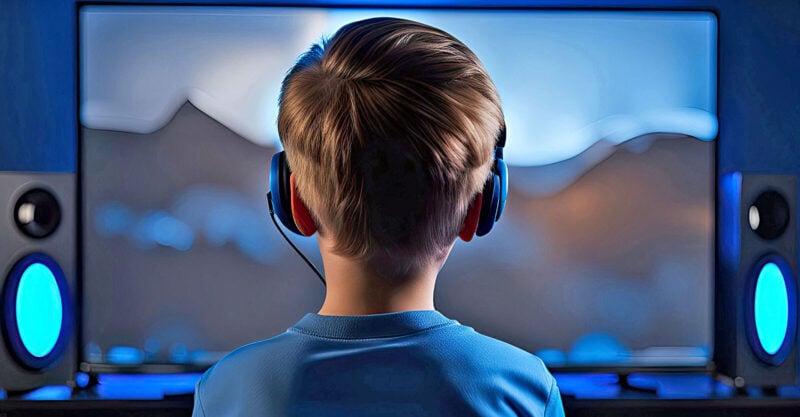Miss a day, miss a lot. Subscribe to The Defender's Top News of the Day. It's free.
Kids with attention-deficit/hyperactivity disorder (ADHD) and autism could benefit from wearing a digital headset that uses artificial intelligence (AI) to train their brainwaves — according to the company that sells the headset.
PigPug, a wireless headset designer, claims it’s “transforming child mental health with AI-powered neurofeedback for kids with ADHD and autism.”
The company’s EEG headset measures kids’ brain’s electrical activity and gives real-time feedback that it claims helps children’s brain function in a particular way.
But critics who spoke with The Defender voiced concerns about using AI to help kids’ brains.
Brian Hooker, Ph.D., Children’s Health Defense (CHD) senior director of science and research and the father of a child with autism, said he was “cautiously optimistic” about PigPug’s product but “wary of such technologies.”
There’s research showing that neurofeedback techniques can be effective in treating autism and ADHD, said Hooker. But, he added, “I don’t see that the AI portion of their technique has been appropriately tested.”
Laura Hanson, a board-certified neurofeedback practitioner and chiropractor who has treated children and adults for more than 15 years, agreed.
Hanson, who also is a neurodevelopmental therapist and autism specialist with an accreditation in reading quantitative EEGs (called QEEGS), said she’s reading, “The Indoctrinated Brain: How to Successfully Fend Off the Global Attack on Your Mental Freedom.”
“I’m really concerned with the push of AI,” she told The Defender. “There is something really happening in our world today that is trying to take over how we think.”
Vitali Karpeichyk, PigPug’s CEO and co-founder, told The Defender he “struggled” with autism since childhood. He said he started the company out of a passion for helping kids with ADHD and autism “to live a better life.”
Hanson thinks Karpeichyk’s “intentions are good,” but she’s concerned that wearing digital headsets may normalize brain surveillance — a hot topic at last year’s World Economic Forum event in Davos, Switzerland — and expose kids to harmful wireless radiation.
Michael Pierce, a board-certified chiropractic neurologist for almost 30 years, has similar concerns.
Pierce, who serves on the American Chiropractic Neurology Board and the International QEEG Certification Board, told The Defender he’s come to believe there are “nefarious forces” aligned with the “medical industrial complex” that are seeking to reduce the population in Africa, India and elsewhere.
“I can’t allow us to ignore the fact that even neurofeedback — any healthcare intervention — could be usurped by those people for those means,” he said.
How does neurofeedback work?
Neurofeedback therapy, which has been around for more than 50 years and doesn’t inherently use AI, is used as a non-invasive alternative treatment to pharmaceutical drugs for a host of mental conditions, including post-traumatic stress disorder in veterans.
There are at least 2,500 scientific papers on neurofeedback therapy. It works by hooking up a patient’s head to an EEG machine, which shows a trained clinician the patient’s brainwave activity.
The clinician can then analyze the EEG output to determine which areas of the brain aren’t working well and, with the patient’s input, recommend interventions to change the patient’s brainwave patterns.
While staying connected to the EEG machine, the patient receives an auditory or visual feedback signal — such as a sound gently increasing in pitch or volume or a screen that gets brighter — as their brain approaches the desired brainwave activity.
Video game changes send signals to the brain
For example, a child using PigPug’s headset — which is made with four silicone-covered dry active electrodes that pick up on brainwave activity — might be watching a video game on an iPad.
The game would get brighter when the child’s brain activity shows he’s in a focused state, explained Karpeichyk. “That’s the training.”
As long as the child receives the signal within less than half a second, she subconsciously associates the signal with the desired brain activity and is more likely to engage in that brain behavior.
Pediatrician Dr. Larry Palevsky told The Defender, “I wouldn’t recommend that children with autism and ADHD, who are overstimulated to begin with, be watching video games on a Wi-Fi-linked headset that is only going to further overstimulate them.”
Nonetheless, some say neurofeedback therapy can improve people’s attention, moods, sleeping habits and even athletic ability.
Research suggests that the changes made during neurofeedback sessions may be long-lasting — and, in the case of ADHD and autism, may reduce a person’s need for medication, Karpeichyk said.
Traditionally, neurofeedback was conducted primarily in clinics where patients were hooked up to expensive EEG machines with as many as 256 channels.
Karpeichyk hopes his company’s headset helps kids with autism and ADHD from families who may not have money to go to a neurofeedback clinic.
Many neurofeedback clinics offer pro-bono sessions to those who can’t pay, said Hanson. “Helping people financially … [is] an ongoing issue for everybody.”
Digital neurofeedback headsets increase wireless radiation exposure
Neurofeedback equipment doesn’t necessarily increase a person’s exposure to wireless radiation, Pierce said. “The electrodes stuck to their head are simply pickups,” he explained. “They simply are sensors. They don’t deliver any electromagnetic field.”
The issue is whether the equipment is hardwired or wireless.
According to Karpeichyk, PigPug’s device connects to the internet using Wi-Fi or Bluetooth and operates at a significantly lower power output compared to standard smartphones.
Parents wanting to reduce their child’s exposure to wireless radiation should use Bluetooth instead of Wi-Fi, Karpeichyk said, because Bluetooth emits less power than Wi-Fi.
However, more than a dozen peer-reviewed studies have shown that exposure to low-intensity wireless radiation can open the blood-brain barrier, suggesting that technologies like Bluetooth may still be dangerous.
Hanson said she uses hardwired equipment because she’s treated several previously healthy adults who developed brain tumors after careers in information technology in which they routinely wore wireless headsets.
“They totally believed that the brain tumors that happened to them were because of the amount of radiation that they were being exposed to,” she said.
Child’s brainwave data gets uploaded to the cloud
The brainwave data picked up by PigPug’s headset is uploaded to the cloud where a telemedicine practitioner can analyze it in real time during a session with the child, Karpeichyk said.
PigPug doesn’t share or sell the data to third parties, the company said. It uses “the best” cloud platforms — Google Cloud and AWS Cloud — when it comes to preventing cyber hackers, Karpeichyk said, and is “committed to implementing robust security measures to minimize any risk of data breaches.”
He acknowledged that no system is entirely immune to hacking.
According to Pierce, it’s highly probable that PigPug may later be bought out or change its data privacy policy by selling users’ data, as many other companies have done. “The only way to know this is to wait for the future and see what happens.”
His advice to parents who may want to get neurofeedback for their child?
“Seek out somebody that uses a database that they know and trust that is protected,” Pierce said. The American Chiropractic Neurology Board’s doctor locator can be a good place to start.
‘Kids need to move’
The Defender asked Karpeichyk about how his company uses AI in its headset.
He said PigPug uses machine learning — a subset of the general AI field — for its gaming content, diagnosing and training.
The child’s EEG output is used to train a neural network for diagnosing and creating individualized programs.
After a few sessions with the human trainer, kids are given the option to continue with training content, personalized to the child’s needs, which is developed via machine learning.
Hanson doubted whether this training content would be as effective as working with a human practitioner in a clinic that uses high-quality neurofeedback equipment regulated by the U.S. Food and Drug Administration (FDA). “I don’t see how it can be apples to apples,” she said.
PigPug’s headset isn’t yet FDA-approved, but the company plans to seek approval, Karpeichyk said.
Hanson also said neurofeedback therapy should be done in conjunction with other modalities, like aerobic exercise and nutrition.
“Kids need to move,” she said. “So if I’m just going to plop you in front of a screen and just expect a neurofeedback tool to wire you back together correctly, you’re not utilizing it correctly.”
Pierce agreed, noting that detoxification from heavy metals is particularly important when treating kids with autism and ADHD.
Will kids wear the digital headset at school?
Karpeichyk said kids typically wear the PigPug headset during two 30-minute sessions per week at home, but that usage may increase. “Probably in the future, this headset will analyze brain activity during the day … at school.”
Such a future may not be far off if the market for adult neurofeedback wearable devices is any indication.
At least 10 companies, including Sens.ai and Muse, are already selling brain-training headsets and headbands to monitor and alter adults’ brain activity.
Karpeichyk said he thinks wearing PigPug’s headset will help kids have “a better, more conscious life.”
However, whether commercial brain-monitoring devices used outside clinical settings can help or hurt kids is still being debated.
China in 2019 piloted brain-scanning headbands on thousands of schoolchildren to monitor concentration levels. The pilot was later halted when parents expressed fears that the devices could be used to control the children and invade their privacy.
Nonetheless, global research on measuring kids’ brainwaves at school has taken place as recently as 2020.
To date, brain research is a major initiative of the National Institutes of Health.










